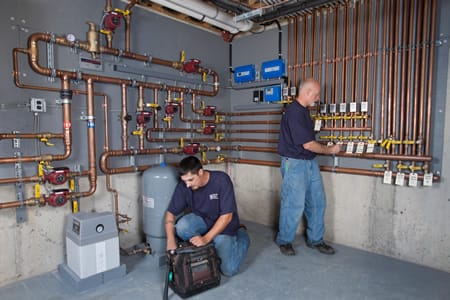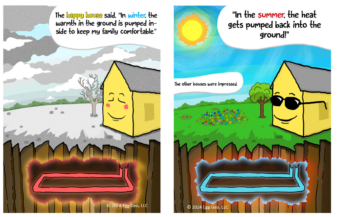The love/hate relationship that exists between the economy and the hydronics industry has not exactly been a marriage made in heaven over the past few years. Recent travails with the economy have put the hydronics market in a holding pattern, yet positive indicators suggest the economy may be softening, and industry experts are forecasting modest growth in the near term for the market as a whole.
According to Terry Teach, vice president of sales, Domestic Building Services, Grundfos, “With the hydronics or ‘wet’ side of the market situated from anywhere from 8-13% of the HVAC market, we’d love to see the size of the pie increase to levels of 15-20%.”
Such optimism should be welcomed, but what exactly could be backing it up? From interest rates and the residential housing market to the lexicon contractors use to sell hydronics, a confluence of factors need to come together to form this perfect hydronics storm. New energy efficient systems, and introductions of innovative products and equipment such as circulators, geo and solar thermal components, condensing boiler options, combi boilers, control systems, installation accessories, and the capability of systems integration, allow the installing hydronics contractor plenty of options to meet both the needs and the budget of the consumer. In addition, the use of PEX tubing for distribution piping in hydronic HVAC systems is growing as a less expensive and less labor-intensive system versus other piping methods.
With reports of increased manufacturer shipments, inventories and orders — while wholesale inventories remaining essentially flat — this could be read as a promising and encouraging outlook. “In conjunction with an upturn in consumer purchases, and new residential construction and sales approaching double digit growth rates, hydronics will no doubt experience increased demand,” says Brian Fenske, specialty channel sales manager and national training manager, Navien America, Inc.
This all plays into the hugely important aspect of consumer confidence, which relates to the state of the economy and the willingness of consumers to spend their money. With this newly found confidence rising, it is incumbent upon the industry as a whole to increase awareness of hydronics as an overall complete comfort system. Often times the battle begins with selling the benefits of hydronics as not just a “luxury” item. “Sadly, too often hydronics systems gets bumped in favor of granite countertops and stainless appliances,” says Rich McNally, senior sales manager, residential & commercial, Watts Water Technologies.
So that begs the question: How do we present hydronics as home comfort systems? “In the end, it’s not a hydronic system, a radiant system or a forced air system — it’s a home comfort system. What matters is the components that go into that home comfort system,” says John Barba, training manager, Taco, Inc.
• Interest Rates/Consumer Confidence. Not necessarily a direct correlation, but in today’s economy increased interest rates do have an effect on increased consumer confidence. “Consumer confidence, low interest rates, and general feelings of well being are huge for want products such as radiant and floor warming,” says McNally.
Because of historically low interest rates, many consumers have been sitting on their hands when it comes to upgrades or discretionary spending. “When interest rates start going up, that may push people to move on projects they’ve been sitting on, whether it’s a new home, second home or major remodel,” says Barba.
Like moths from a wallet, when it comes to departing with one’s hard-earned dollar, interest rates, job creation and bank lending flexibility, for example, can give us all the “warm and fuzzies,” and can lead to a more confident consumer. “The consumer spending index that has faltered a bit continues to show promise. Homeowners will tighten their belts for awhile, but eventually they cannot continue to ignore home improvements and more importantly their comfort,” says Fenske.
• Residential/Commercial Market. Housing starts and commercial construction billings are indicators of growth of the residential and commercial building markets, respectively. The residential business is entrenched primarily in the luxury home segment, where the construction upturn is beginning to move in the positive direction. “However, the long building cycle of luxury homes can delay the impact of the housing upturn for the hydronics market,” says Mark Hudoba, director, heating and Cooling, Uponor.
While complete hydronics systems in non high-end homes may not be the norm moving forward, “What we are seeing is the transition of radiant heating into the mainstream of residential construction. Other than in higher-end construction, it will be increasingly rare to see an entire home heated with radiant floor heating. You should continue to see bathrooms and kitchens with radiant, in conjunction with panel radiators, baseboard and hydro-air coils in forced air systems,” says Barba.
Uponor’s Hudoba contends that the commercial radiant heating and cooling business continues to gain traction with designers and engineers looking to solve issues with standard heating systems and/or achieve LEED certification.
• Investment in training. Manufacturers and contractors alike stress the importance of training in today’s business landscape. “Because contractors have such an influence at the homeowner level, training is critical,” says Teach. Well-educated contractors can help customers get the kind of home comfort system that works best for them and best fits their needs. Being adept at several different types of systems — from condensing and non-condensing boilers to hydro-air systems and air-to-water heat pumps allows a contractor to offer a myriad of solutions to their customer base. “It’s training, training, training. I’ve always felt that a strong, well-trained army of contractors is the best tool for long-term, sustainable market growth. As my old man said, it’s what you learn after you know it all that really counts,” says Barba.
• New Technology/Energy Efficiency. According the Navien’s Fenske, boilers are being designed and offered with more options and sizes to meet the application requirements. Venting of the appliances has never been easier with an abundance of options to meet the equipment and installation requirements. Control integration, and most importantly might be the outdoor reset requirement, that truly motivates the skilled hydronic craftsmen to design the best and most efficient comfortable system.
However, there are differing schools of thought when it comes to selling overall efficiency to customers. “I think we need to really understand the entire concept of efficiency so that we can better share that concept with our customers. First of all, a new boiler or new water heater is never going to ‘pay for itself’ unless it gets a paper route.
“There’s no such thing as a meaningful ‘payback’ or ‘ROI’ on home comfort systems. There’s nothing ‘efficient’ about ripping out a 10-year-old cast iron boiler and putting in a new high-efficiency model. The wiser approach is to show customers what they get with a ‘better’ system in terms of comfort, efficiency and other benefits compared to what they would give up by going with merely a ‘good’ system. To make the discussion purely financial — in terms of energy saving dollars — is very limiting. Efficiency is important, but its only one benefit. With a well-conceived home comfort system, there are dozens of benefits for customers that shouldn’t be ignored. Focusing on efficiency alone misses out on all those other benefits,” says Barba.
• Replacement Market. A huge chunk of the hydronics market is dependent upon service, repair and replacement. And, since a high percentage of the hydronics market consists of replacement, if external factors such as mild winters aren’t causing stressed systems, the demand for systems and components goes down. In addition, although more work needs to be done, continued rebuilding after last year’s hurricane Sandy will see homes rebuilt with hydronic heating systems.
Couple new technology with ongoing training, and hydronics installers have a lot of potential in terms of education and retraining on new equipment that is being offered today. This should add up to a renewed rigor in hydronic equipment and accessory sales.
This feature also can be seen at http://contractormag.com/hydronics-systems/five-economic-indicators-could-signal-upswing-hydronics-market





Join the conversation: